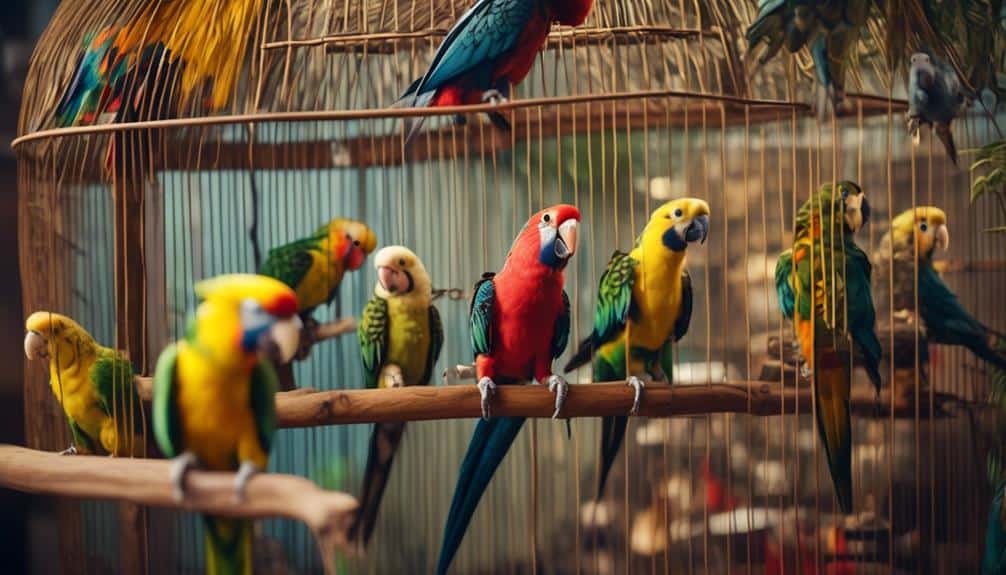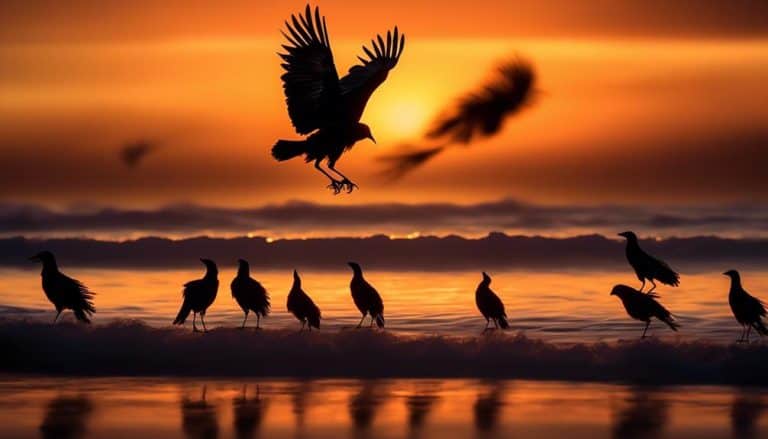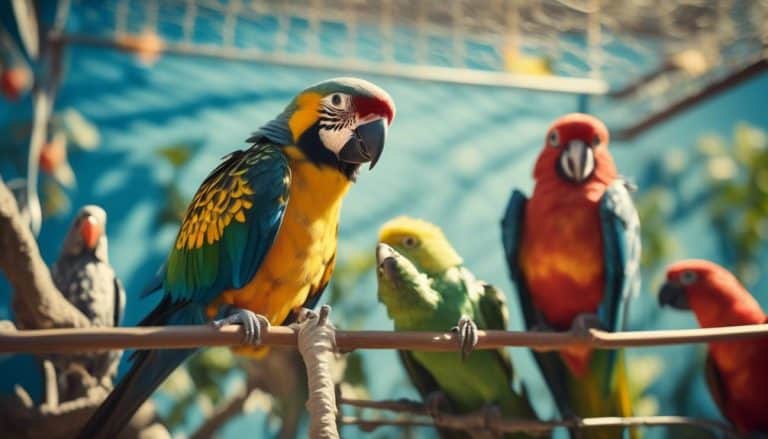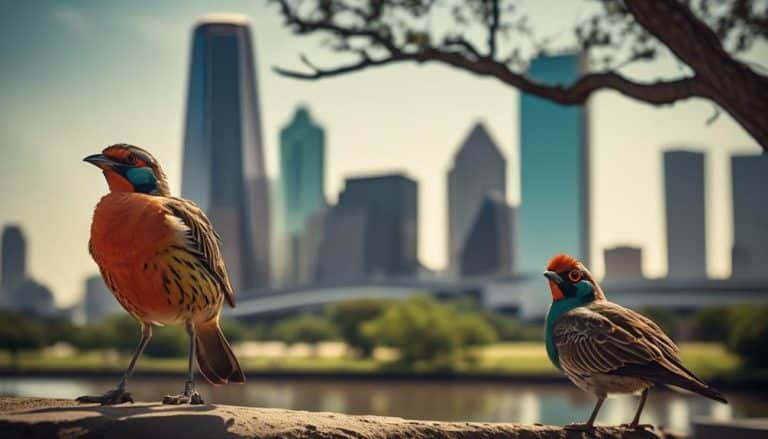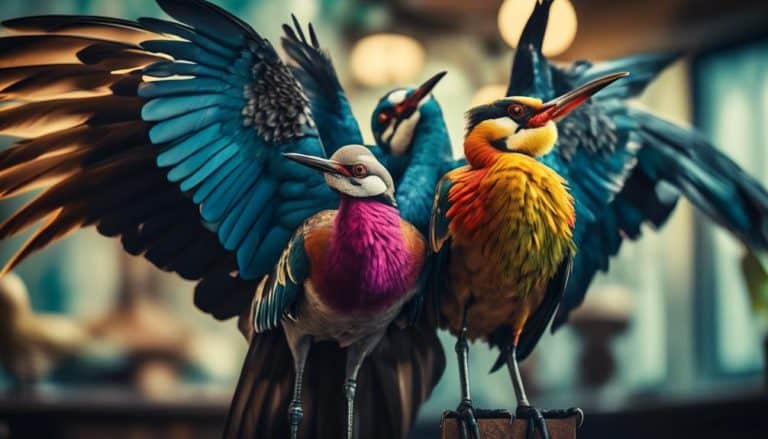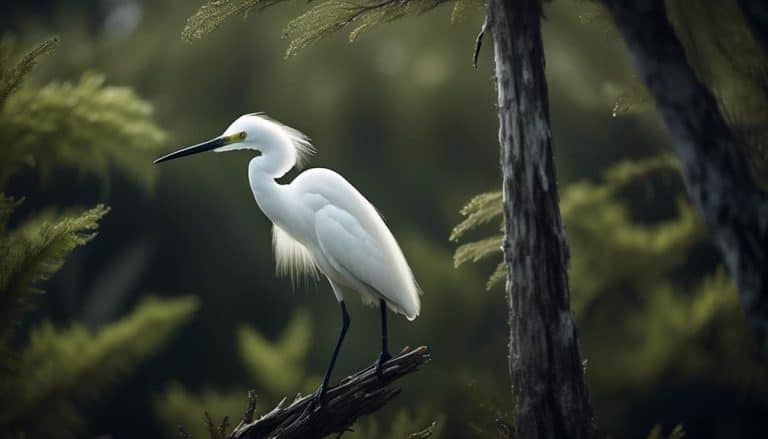So you're a bird lover, huh? Well, hold onto your feathers because I'm about to reveal a surprising fact: California has an astounding variety of birds that are legal to own.
From colorful parrots to melodious canaries, the possibilities are endless. But before you start dreaming of a backyard filled with feathered friends, there are some important regulations you need to know.
Stay tuned as we explore the fascinating world of avian companionship in the Golden State. You won't want to miss this!
Parrots and Cockatoos
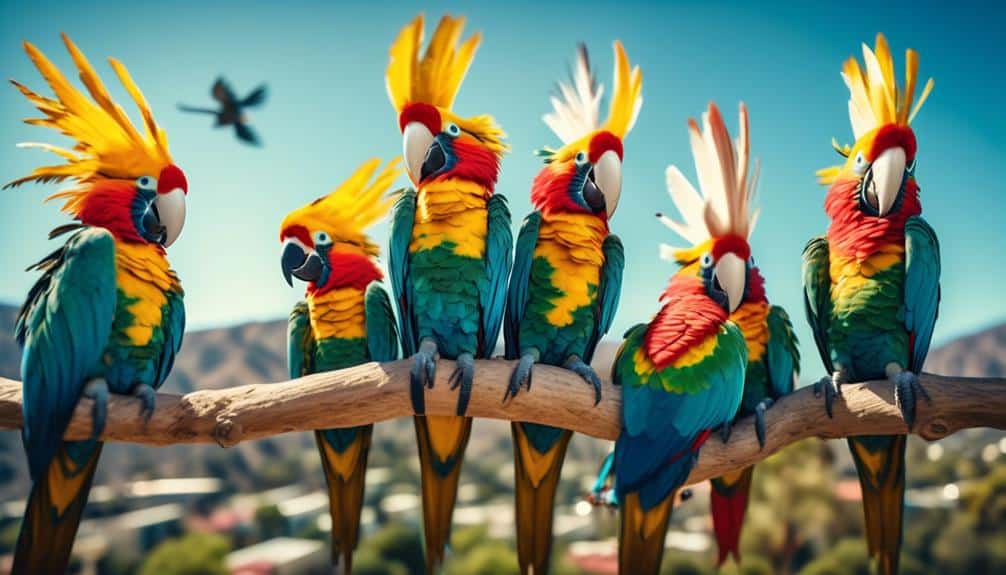
Parrots and Cockatoos are popular avian pets in California due to their vibrant plumage, intelligent nature, and ability to mimic human speech. When it comes to training techniques for these birds, positive reinforcement is the key. Parrots and Cockatoos are highly intelligent creatures and respond well to rewards and praise. Training sessions should be short and frequent, focusing on one behavior at a time. Repetition and consistency are crucial for effective training.
Health and nutrition considerations for Parrots and Cockatoos are of utmost importance to ensure their well-being. These birds have specific dietary requirements that must be met to maintain optimal health. A balanced diet for these birds should consist of a variety of fresh fruits, vegetables, grains, and a quality commercial pellet or seed mix. It's essential to provide them with plenty of fresh water as well.
Regular veterinary check-ups are essential to monitor the overall health of these birds. Common health issues in Parrots and Cockatoos include respiratory infections, feather plucking, and beak and nail overgrowth. Providing them with a safe and clean environment is also crucial to prevent the spread of diseases.
Canaries and Finches
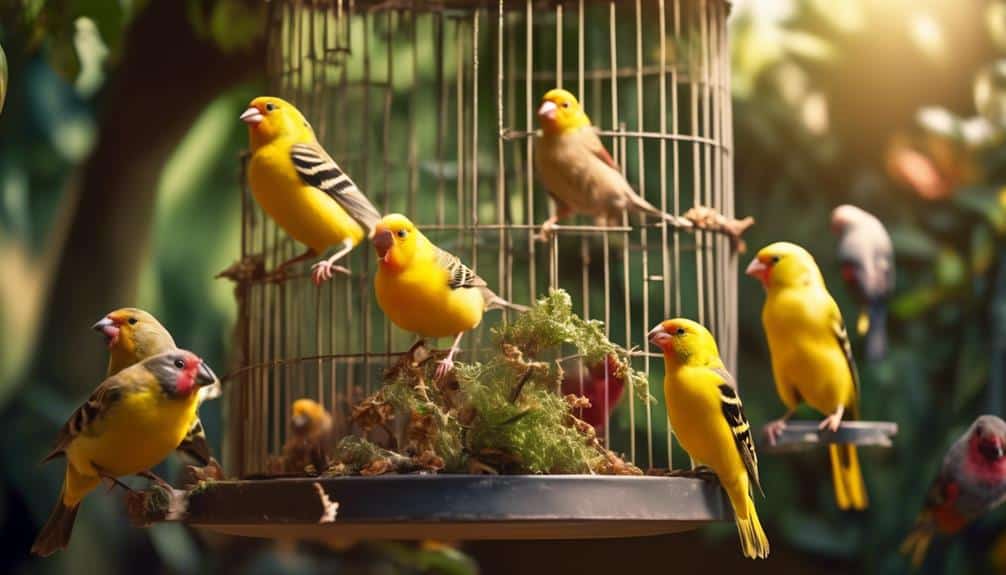
Canaries and Finches are small songbirds that are legal to own in California. These birds make popular pets due to their beautiful plumage and melodious songs. Breeding canaries can be an enjoyable and rewarding experience for bird enthusiasts.
To successfully breed canaries, it's important to provide them with a suitable nesting area, such as a small nest box filled with soft materials like feathers and grass. Canaries require a diet rich in seeds, fruits, and vegetables, along with a constant supply of fresh water. It's important to provide a balanced and varied diet to ensure their nutritional needs are met.
Finches, on the other hand, are known for their vibrant colors and lively personalities. They require a spacious cage with plenty of perches and toys to keep them entertained. Finch care involves providing a diet consisting primarily of high-quality finch seed mix, supplemented with fresh fruits and vegetables. It's crucial to regularly clean their cage and provide them with fresh water.
Lovebirds and Budgies
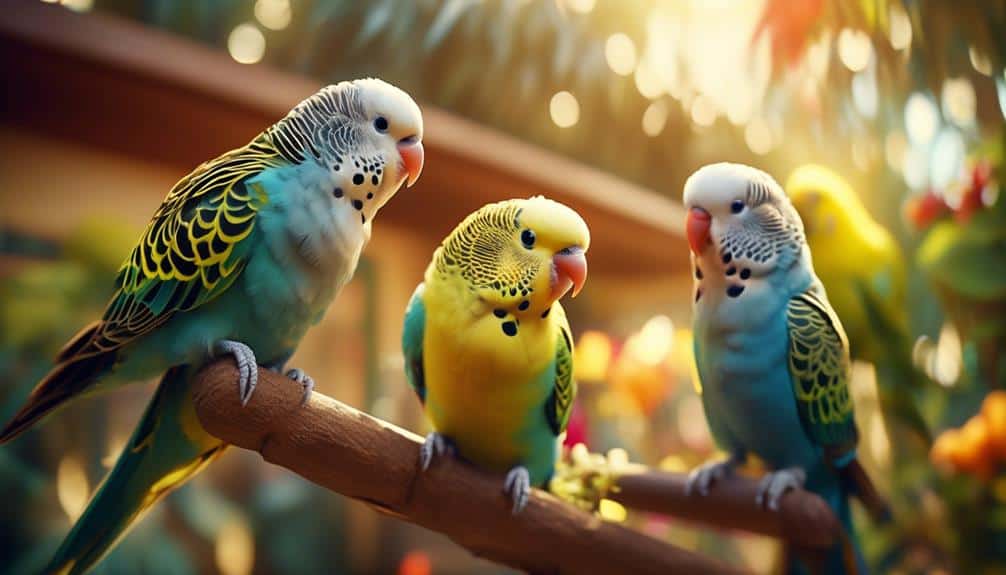
Lovebirds and Budgies, also known as parakeets, are popular pet birds in California due to their colorful plumage and playful personalities.
Breeding lovebirds is a fascinating and rewarding endeavor. Lovebirds are monogamous birds, forming strong pair bonds. To successfully breed lovebirds, it's important to provide them with the right environment. This includes a spacious cage with nesting boxes, perches, and a variety of toys. Lovebirds also require a balanced diet consisting of fresh fruits and vegetables, high-quality pellets, and seeds.
When it comes to training budgies, patience and consistency are key. Budgies are intelligent birds and can learn various tricks and behaviors. Start by establishing trust with your budgie through positive reinforcement and rewards. Use a clicker or verbal cues to communicate with your bird during training sessions. Teaching basic commands like stepping up onto your finger or perch can help establish a bond with your budgie. Gradually introduce more complex tricks and behaviors, such as playing dead or retrieving objects.
Pigeons and Doves
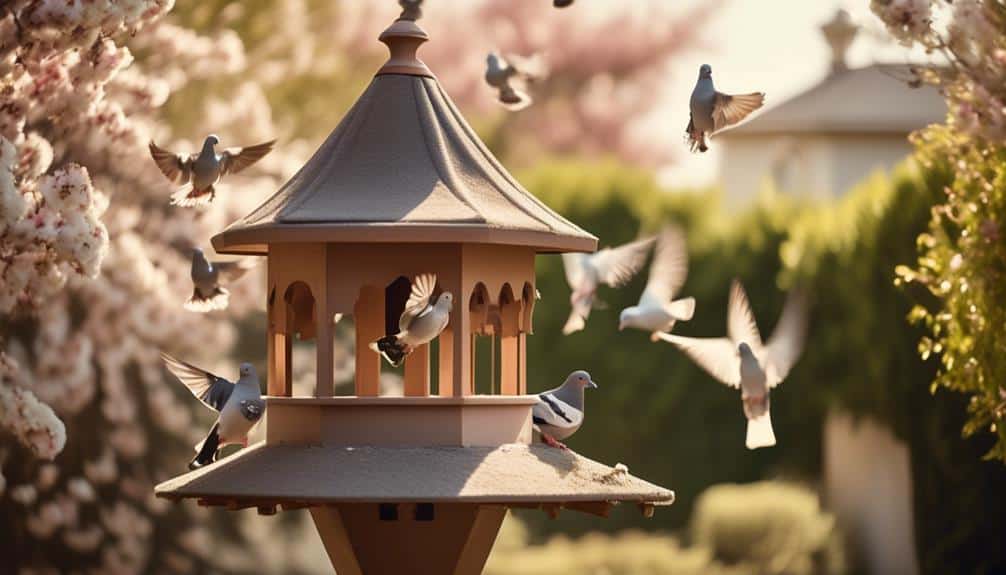
Pigeons and doves, often overlooked as pet birds, offer unique characteristics and behaviors that make them a fascinating addition to any bird enthusiast's collection. These birds are known for their gentle nature, soft cooing sounds, and beautiful plumage.
In addition to their aesthetic appeal, pigeons and doves also have interesting breeding habits and color variations. Breeding habits among pigeons and doves can vary depending on the species. Some species, such as the Rock Pigeon, build nests in tall structures like buildings and bridges. They lay one or two eggs at a time and both parents take turns incubating the eggs.
Other species, like the Mourning Dove, build flimsy nests made of twigs and lay two eggs at a time. The male and female share nesting responsibilities and take turns sitting on the eggs.
When it comes to color variations, pigeons and doves come in a wide range of hues. Some species, like the White Dove, are predominantly white with a few gray or black markings. Others, like the Rainbow Pigeon, display vibrant colors ranging from red and green to blue and purple. These color variations are the result of genetic mutations and selective breeding.
Quails and Pheasants
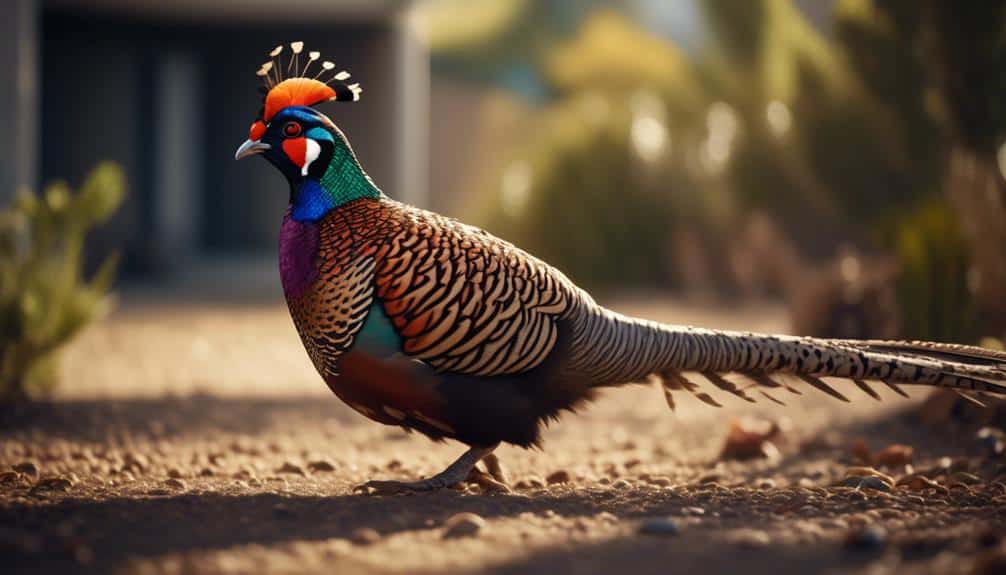
Quails and pheasants, often sought after for their unique characteristics and striking appearances, are intriguing additions to any avian enthusiast's collection. These birds have specific habitat requirements that must be met in order to ensure their health and well-being. Quails, for instance, prefer habitats with dense vegetation and brushy areas, as they provide cover and protection. Pheasants, on the other hand, thrive in open grasslands and agricultural fields, where they can forage for food and find suitable nesting sites.
Breeding and reproduction are important aspects to consider when owning quails and pheasants. Quails are known for their prolific breeding habits, with females laying up to 12 eggs at a time. They typically build their nests on the ground, hidden among vegetation. Pheasants, on the other hand, have more complex courtship and mating behaviors. Males display their colorful plumage and perform elaborate courtship dances to attract females. Once a pair is formed, the female will lay a clutch of eggs, usually in a well-hidden nest.
Providing the appropriate habitat and understanding the breeding behaviors of quails and pheasants is crucial for their successful care and reproduction. By meeting their specific requirements, avian enthusiasts can enjoy the beauty and charm that these birds bring to their collections.
Peafowls and Game Birds
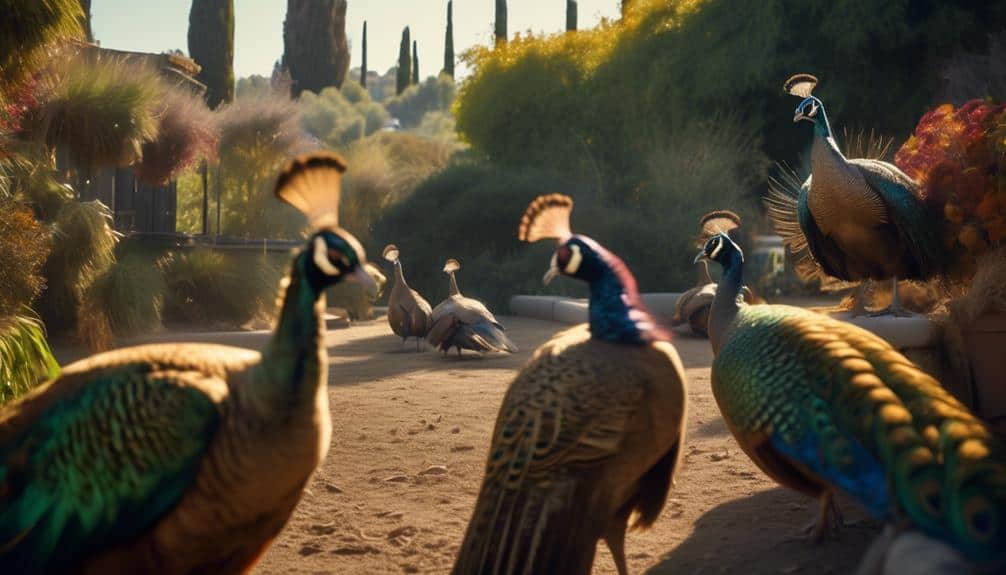
Peafowls and game birds, such as pheasants and turkeys, are captivating avian species that offer a vibrant display of colors and intriguing behaviors. These birds have unique characteristics and require specific considerations when it comes to raising them in residential areas.
Raising peafowls in residential areas: Pros and cons
- Pros:
- Peafowls are beautiful birds with striking plumage, adding aesthetic value to your property.
- They're relatively easy to care for and can adapt well to different climates.
- Peafowls can help control pests like insects and rodents.
- They can provide a source of entertainment with their elaborate courtship displays and distinctive calls.
- Cons:
- Peafowls can be noisy, especially during their breeding season, which might disturb neighbors.
- They require ample space to roam and forage, which might be limited in a residential setting.
- Peafowls can be prone to certain diseases, requiring proper veterinary care.
- Their droppings can be messy and potentially damage property if not managed properly.
Game bird hunting regulations in California: A comprehensive guide
- California has specific regulations for hunting game birds, including pheasants and turkeys.
- Hunters must possess a valid hunting license and follow the designated hunting seasons.
- Bag limits and possession limits are set for each species, ensuring sustainable hunting practices.
- It's important to check the California Department of Fish and Wildlife for updated regulations and any special restrictions in certain areas.
When considering raising peafowls in residential areas or participating in game bird hunting, it's crucial to understand and abide by the relevant regulations to ensure the well-being of the birds and compliance with the law.
Frequently Asked Questions
Are There Any Restrictions on Owning Exotic or Non-Native Bird Species in California?
There are regulations in place regarding exotic bird ownership and restrictions on non-native bird species in California. It is important to be aware of these rules to ensure compliance and the well-being of the birds.
What Are the Regulations Regarding the Noise Level of Pet Birds in Residential Areas?
Living in a residential area with pet birds can be challenging due to regulations on noise levels. The impact of bird noise on neighbors' quality of life is a crucial consideration that should be addressed.
Can I Legally Breed and Sell Birds as a Hobbyist in California?
I can legally breed and sell birds as a hobbyist in California as long as I comply with the legal requirements and breeding regulations set by the state. It's important to understand and follow these guidelines to ensure a responsible and legal practice.
Are There Any Specific Permits or Licenses Required to Own Certain Bird Species in California?
In California, owning certain bird species may require permits or licenses. To legally own specific birds, it is important to understand the requirements and follow the guidelines set forth by the state.
What Are the Penalties for Illegally Owning or Selling Birds in California?
Illegal ownership or sale of birds in California can lead to severe consequences and penalties. Unauthorized bird trafficking is taken seriously, and legal actions, including fines and imprisonment, can be imposed on offenders.
Conclusion
In conclusion, it's important to note that California has strict laws regarding the ownership of birds.
However, one interesting statistic to highlight is that parrots and cockatoos are among the most popular birds kept as pets in the state. According to a survey conducted by the American Pet Products Association, an estimated 7.5 million households in California own pet birds, with parrots and cockatoos being the most favored species.
This statistic underscores the enduring popularity and appeal of these intelligent and colorful birds in the state.

